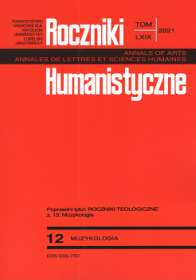Neapolitańska praktyka wykonawcza w instrumentalnej muzyce zespołowej XVIII wieku
Abstrakt
Gdy mówimy o szkole neapolitańskiej mamy na myśli twórców muzyki operowej i wokalnej, tymczasem w Neapolu rozwijała się także wielobarwna twórczość instrumentalna. Jej znajomość jest słaba nawet wśród badaczy tego ośrodka. Przedmiotem niniejszego artykułu jest neapolitańska twórczość instrumentalna na różnego rodzaju zespoły kameralne i orkiestrowe, powstająca przez 100 lat począwszy od lat 90. XVII wieku. Neapolitańskie zwyczaje wykonawcze odbiegały od tych znanych z innych ośrodków europejskich. Mimo uprawiania tych samych gatunków (sonaty, koncertu, symfonii), twórcy neapolitańscy przejawiali odmienne preferencje obsadowe. Niezależnie od gatunku chętnie posługiwali się zespołem złożonym z trojga lub czworga skrzypiec i basu. Unikali stosowania altówki, rzadziej w roli instrumentu solowego obsadzali skrzypce, chętniej flety, wiolonczelę, mandolinę i instrumenty klawiszowe. Nie typ aparatu wykonawczego stanowił w Neapolu o tym czy mamy do czynienia z sonatą, koncertem czy symfonią, lecz faktura i forma. Gatunek muzyczny nie miał też wpływu na to czy utwór będzie wykonywany kameralnie czy orkiestrowo.
Bibliografia
Bukofzer, Manfred. Muzyka w epoce baroku: Od Monteverdiego do Bacha. Państwowe Wydawnictwo Naukowe, 1970.
Bettarini, Luciano. „Appunti critici sulle ‘Sette Sonate’ per flauto e archi di Alessandro Scarlatti”. Chigiana, t. 25, 1968, ss. 239-246.
Bossa, Renato. „Le sonate a quattro di Giuseppe Antonio Avitrano (1713)”. Miscellanea musicologica, nr 2, 1987, ss. 307-322.
Burney, Charles. A General History of Music from the Earliest Ages to the Present Period. To Which is Prefixed, A Dissertation on the Music of the Ancients, t. 3, Burney, 1789.
Degrada, Francesco. „Le musiche strumentali di Nicolò Porpora.” Chigiana, t. 25, 1968, ss. 99-125.
Dent, Edward J. „The Earliest String Quartets”. The Monthly Musical Record, t. 33, 1903, ss. 202-204.
De Rosa, Carlo Antonio. Memorie dei compositori di musica del regno di Napoli raccolte dal marchese di Villarosa. Stamperia Reale, 1840, s. 142.
Di Benedetto, Renato. „The Sonate a quattro of Angelo Ragazzi (1736)”. International Musicological Society Congress Report (Copenhagen, 1972), ed. Henrik Glahn et al., Edition W. Hansen, 1974, ss. 356-365.
Evelyn, John. „Diary”. The Diary of John Evelyn, ed. William Bray, t. 2, M. Walter Dunne, 1901.
Fertonani, Cesare. „Musica strumentale a Napoli nel Settecento”. Storia della musica e dello spettacolo a Napoli: Il Settecento, red. Francesco Cotticelli, Paologiovanni Maione, Edizioni Turchini, 2009, ss. 925-963.
Gjerdingen, Robert. Music in the Galant Style. Oxford UP, 2007.
Halton, Rosalind. „«Senza cimbalo al tavolino»: Alessandro Scarlatti and his 4 Sonate a quattro”. Studi musicali, Nuova serie, t. 6, nr 1, 2015, ss. 97-130.
Hill, John Walter. Baroque Music: Music in Western Europe, 1580-1750. W.W. Norton & Company, 2005.
Hutchings, Artur. The Baroque Concerto. Faber and Faber, 1959.
Lattanzi, Alessandro. „Il repertorio napoletano di concerti per strumenti a fiato. Materiali per una ricognizione preliminare”. Studi Pergolesiani, nr 10, 2015, ss. 125-158.
Maunder, Richard. The Scoring of Baroque Concertos. The Boydell Press, 2004.
McVeigh, Simon, i Jehoash Hirshberg. The Italian Solo Concerto, 1700–1760: Rhetorical Strategies and Style History. The Boydell Press, 2004.
Olivieri, Guido. „Musica strumentale a Napoli nell’età di Pergolesi: Le sonate per tre violini e basso”. Studi Pergolesiani, nr 4, 2000, ss. 193-207.
Olivieri, Guido. „Tra Napoli e Vienna: Musicisti e organici strumentali nel viceregno austriaco (1701–1736)”. Analecta musicologica, t. 32, 2002, ss. 161-182.
Olivieri, Guido. The „Fiery Genius”: The Contribution of Neapolitan Virtuosi to the Spread of the String Sonata (1684-1736). UMI, 2005, s. 221.
Olivieri, Guido. „Cello Playing and Teaching in Eighteenth-Century Naples: F. P. Supriani’s Principij da imparare a suonare il violoncello”. Performance Practice: Issues and Approaches, ed. Timothy D. Watkins, Steglein Publishing, 2009, ss. 109-136.
Sanguinetti, Giorgio. The Art of Partimento: History, Theory, and Practice. Oxford UP, 2012.
Sigismondo, Giuseppe. Descrizione della cittá di Napoli e suoi borghi, t. 3, Fratelli Terres, 1789, s. 202.
Talbot, Michael, i Rosalind Halton. „«Choice Things of Value»: The Mysterious Genesis and Character of the VI Concertos in Seven Parts Attributed to Alessandro Scarlatti”. Eighteenth-Century Music, t. 12, nr 1, 2015, ss. 15-16.
Timpe, Christoph. „Violinmusik in Neapel in der ersten Hälfte des 18. Jahrhunderts”. Analecta musicologica, nr 32, 2002, ss. 183-208.
Van Tour, Peter. Counterpoint and Partimento: Methods of Teaching Composition in Late Eighteenth-Century Naples. Upsala U, 2015.
Wilk, Piotr. „The Concerto in the Oeuvre of Nicola Fiorenza”. Ad Parnassum. A Journal of Eighteenth- and Nineteenth-Century Instrumental Music, t. 17, nr 33, 2019, ss. 1-43.
Wilk, Piotr. „«New» Cello Concertos by Nicola Porpora”. Musica Iagellonica, t. 11, 2020, ss. 5-36.
Copyright (c) 2021 Roczniki Humanistyczne

Utwór dostępny jest na licencji Creative Commons Uznanie autorstwa – Użycie niekomercyjne – Bez utworów zależnych 4.0 Międzynarodowe.





